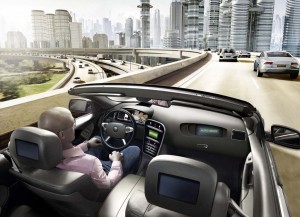Continental, one of the world’s top automotive suppliers, has become the first company to win approval from the Nevada Department of Motor Vehicles to test autonomous vehicles on the state’s wide open highway.
With extensive stretches of good roads with little traffic, Nevada has become a popular state for testing out new autonomous vehicle technologies – which led the state to enact new rules creating a special class of license for self-driven automobiles. The first official license plate, which features an infinity symbol, was granted to Google, the tech firm taking a lead in the field. Continental is the first automotive supplier to seek and receive the special license.
“As a company, Continental’s strategy is clearly focused on making this type of future technology a reality. It’s clear to us that automated driving will be a key element in the mobility of the future,” said Elmar Degenhart, chairman of the executive board of Continental. “As a system supplier, we are perfectly positioned to develop and launch series production of solutions for partially automated systems for our customers by 2016.”
But the goal, he said, is to take the technology even further, “ultimately (with) fully automated driving, even at higher speeds and in more complex driving situations, ready for production by 2020 or 2025.”
After completing driving demonstrations this week in Carson City, the DMV’s Autonomous Review Committee approved Continental’s safety plans, employee training, system functions and accident reporting mechanisms.
“Earning this license represents an important intermediate step towards automated driving for Continental,” said Christian Schumacher, Head of Continental’s Advanced Driver Assistance Systems (ADAS) Business Unit in NAFTA. “Continuing our research and testing in the most challenging environment – public roads — under the highest safety standards, will allow us to continue to assess and develop our highly automated vehicle. This vehicle demonstrates what modern technology can do to provide a safer, more comfortable drive.”
Though several states have been moving to permit autonomous vehicle testing, notably California which recently approved a licensing measure, Nevada was the first and has already received numerous applications for licensing.
“We are proud that our state is serving as the platform for automated testing and licensing. Nevada’s steady climate, varying terrains and driving conditions offer an excellent opportunity for more companies, especially automotive organizations, to take advantage of this autonomous driving opportunity,” said Troy L. Dillard, Director Nevada Department of Motor Vehicles.
There are a growing number of tests underway in cities around the world. Some involve fully autonomous vehicles in which the onboard operator is simply there to take over in the event of a systems failure. Other tests are focusing on more limited technologies that would allow vehicles to communicate with one another – to fire alerts about weather, traffic or accidents, for example.
The University of Michigan has now wired up 3,000 cars for an experiment in automated roadways, which are helping guide vehicles around the City of Ann Arbor, Mi. Every automaker in the world has commissioned tests of automated vehicles, according to a senior executive at one of the industry’s top engineering consulting firms.
“Automated vehicles, such as the one Continental is testing, illustrate the extensive research and development occurring within the automotive industry and embody the future of a vehicle equipped to make the driving experience safer and more enjoyable,” Dillard said.
Continental’s current highly automated vehicle is designed to always have a driver monitoring the vehicle behind the wheel, unlike a completely automated vehicle. Designed as a driver assist system, the automated vehicle can accommodate multiple driving scenarios. Utilizing four short-range radar sensors (two at the front, two at the rear), one long-range radar and a stereo camera, the vehicle is capable of cruising down an open freeway as well as negotiating heavy rush-hour traffic.
Taking advantage of Continental’s sensor fusion technology as part of the ContiGuard safety concept, the vehicle is able to track all objects as they enter into the sensors’ field of view. The object information is then processed and passed on to the Continental Motion Domain Controller to control the vehicle’s longitudinal and lateral motion via signals to the engine, the brakes and the steering system.
The test vehicle, which has logged more than 15,000 miles, is built primarily with equipment that is already available in series production. Continental’s short term goal is to relieve the driver of tedious and monotonous activities, such as driving on highways with minimal traffic or in low-speed situations like traffic jams, company representatives said.
However, they also noted while the concept of autonomous driving is proving to be valid, it is not yet “fully viable,” Continental representatives said.
Continental’s highly automated vehicle represents an intermediate step toward autonomous driving. The equipment used for Continental’s automated vehicle differs from the customized sensors and tailor-made actuators found in other automated vehicles.

